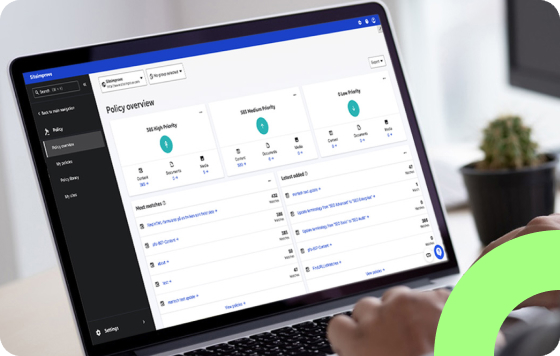ACCESSIBILITY & DIGITAL GOVERNANCE: QA & CUSTOM RULES
Flawless content, instant credibility
Once a site visitor sees or experiences a problem, they can’t unsee it. Because every broken link, misspelling, unsafe domain, PDF issue, and fragment of outdated content is a liability, you need to eliminate every error to ensure your brand shines on every page.

Customized checks, collaborative fixes
Building a flawless website takes a team, but luckily, all you need is one toolbox. Imagine creating and unleashing content rules tailored to your organization’s needs, resolving errors in just a few clicks, and seeing your progress reflected in one score. High-fives all around.
Benefits and key features
Configure as many policies as you like
Is there a word that needs to be replaced globally? Outdated images? A former employee’s name that needs to be removed? An HTML tag that should be retired? Page titles that are too long? Find it on the page or in the HTML and fix it, pronto.
Automate performance checks
Check web pages for slow loading as often as you like and in just a few minutes. Visitor Profiles reflect and simulate combinations of locations, devices, and network conditions.
Prioritize and assign fixes easily
Designate team members to take on particular issues, then with our CMS plugin, they can fix them from right within your CMS. With new pages, Prepublish will catch and remediate errors before they go live.
Watch your score climb
Your Quality Assurance Score, a component of your DCI® score, is easy to share, understand, and celebrate. Traffic analytics show how your content quality contributes to increases in visitors.
Most common use cases
No more journeys that end before they should
Abandoned customer journeys are often the result of broken links, slow loading, or unsafe domains. Robust quality assurance protocols help identify and rectify these issues before they impact the user experience and block conversions, not to mention reflect poorly on your brand.

Proactive testing keeps errors at bay
Siteimprove automatically tests for potential issues like poor readability and misspellings. You’ll know which pages are affected and can fix them quickly and improve the user experience. This proactive approach allows for continuous enhancement and ensures that your content remains accessible and engaging to all users.

A policy tool that does just what you need it to
With our Policy capabilities, you can customize what you want Siteimprove to detect. Create custom tools within QA, Accessibility, SEO, and Analytics; once Siteimprove crawls your website, the Policy tool runs through that data and provides an overview of all the current policy matches it finds in the HTML or on-page content.

Be prepared for every update, redesign, and rebrand
The inventory shows you what content exists on your website, so you’re fully informed on your next redesign or rebrand project. A comprehensive understanding sets you up for strategic decision making and ensures that nothing valuable is overlooked during the update process.

Quality Assurance and Custom Rules FAQs
The tools help identify and resolve issues like broken links, misspellings, unsafe domains, PDF issues, and outdated or non-compliant content.
Siteimprove allows users to create and implement custom policies and rules tailored to their brand guidelines, legal requirements, or specific content standards, such as ensuring specific terminology is used or avoided.
Within the platform, issues can be prioritized. The CMS plugin allows for many issues to be fixed directly within your content management system, streamlining the resolution process.
The Quality Assurance Score is part of the overall DCI® Score. It provides a clear metric to track content quality over time and helps demonstrate the impact of improvements, which can be correlated with website traffic and user engagement.
The Policy tool allows you to set and enforce custom rules and guidelines across various disciplines, including Quality Assurance, Accessibility, SEO, and Analytics, by scanning your website and highlighting instances where these policies are not met.